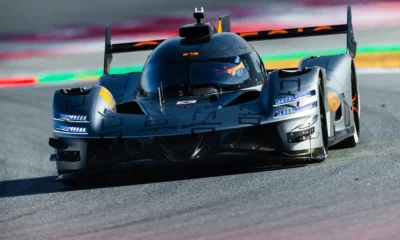
Photo: Brian Cleary/bcpix.com
Following a pair of private tests at Daytona, IMSA is close to finalizing the technical specification of the Daytona Prototype for next month’s TUDOR United SportsCar Championship season-opener.
Select DP teams took the 3.56-mile oval/road course last week to evaluate updated tires from Continental and a revised aero package. It was the first run since official testing in November, which was cut short due to tire failures and airborne accidents by both Richard Westbrook and Joao Barbosa.
GM teams completed additional testing at Daytona on Tuesday and Wednesday of this week, with IMSA’s tech chief Scot Elkins on hand to monitor the progress being made with some new developments.
“We’ve been attending the tests, even though they were private, working with Continental and working with the manufacturers to keep an eye of what was going on,” Elkins told Sportscar365. “It was a good, collaborative effort. Continental came with a couple of different tires for the teams to try.
“We reduced some of the aerodynamic load by removing the diffuser on the [DP] car and it seems like we’ve got ourselves in a pretty good place right now.”
While the initial 2014-spec DP produced a 60 percent increase in downforce, Elkins said the removal of the diffuser essentially cut it in half, reducing the load by roughly 500 pounds.
Adjustments were also made to the rear wing settings, in order to control the top speed and drag, as well as creating cut-outs over the wheel arches to help prevent cars from becoming airborne.
“We still had more downforce than the previous 2013 package but it seemed to work out pretty well,” Elkins said. “We’re going to the wind tunnel at the end of the month to do some Balance of Performance testing between the Ford and the Corvette [bodywork] to finalize that Daytona specification.”
As a result, DPs were noticeably quicker around Daytona. Some top speeds exceeded 190 mph, with lap times in the 1:38 range, which was more than 1 second faster than the previous DP track qualifying record.
The P2 platform, however, has yet to reach those numbers. Extreme Speed Motorsports’ HPD ARX-03b shed the 60kg ballast imposed by IMSA at last month’s test and also ran a larger air restrictor, but managed to only get into the 1:41 range. The Honda-powered prototype topped out at 184 mph on the Florida high banks.
Elkins said he doesn’t expect any further adjustments to be made to the DPs, meaning changes will potentially be done to the P2 cars in order to speed them up. However, he admitted an even larger air restrictor has likely been ruled out as it could compromise engine reliability.
“The target for the last couple of weeks has been working on the DP cars and getting the Daytona setup for those guys,” Elkins said. “We’re going to have more examples of P2 cars at the Roar. That will help us gather more data. We’ll take that and we’ll make some final decisions on the P2/DP balance after the Roar, probably.”
Elkins anticipates releasing a set of DP specifications for Daytona following the wind tunnel validation tests late this month. A complete rulebook for the combined Prototype class, meanwhile, will be released after the Roar Before the 24 on Jan. 3-5.
While DP cars will not use the diffuser at Daytona, Elkins said he believes it will be in place for the balance of the season.
Minor changes have also been put into place in the Prototype Challenge class for the TUDOR Championship season-opener. Teams will be allowed to run a taller top gear, in order to meet the series’ targeted 1:41 lap time for the Oreca FLM09s.
Specifications in GT Le Mans are expected to remain unchanged, but a reduction in power is on tap for GT Daytona. Elkins said a draft set of rules has been distributed to manufacturers, with it hopefully being released in the next few days.
























